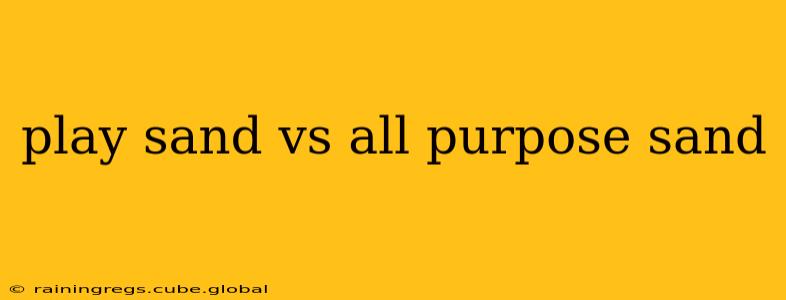Choosing the right sand for your project can make all the difference. Whether you're building a magnificent sandcastle on the beach or tackling a more ambitious landscaping project, understanding the differences between play sand and all-purpose sand is crucial. This comprehensive guide will delve into the specifics, helping you make an informed decision.
What is Play Sand?
Play sand, as its name suggests, is specifically designed for children's play areas. It's meticulously cleaned and processed to remove sharp edges, debris, and potentially harmful contaminants. This makes it much safer for children to handle and play with, minimizing the risk of cuts or injuries. Its finer grain size also contributes to its smooth texture.
Key Characteristics of Play Sand:
- Fine Grain Size: This contributes to its smooth texture, making it ideal for molding and shaping.
- Washed and Cleaned: Removes impurities, ensuring it's safe for children.
- Consistent Color: Typically a light beige or tan.
- Lower Silica Content (Generally): Although silica is naturally present in all sand, play sand typically undergoes processing to minimize its concentration. However, it's always best to check the specific product information.
What is All-Purpose Sand?
All-purpose sand, on the other hand, is a more versatile option. It's less refined than play sand, often containing a wider range of particle sizes and potentially more impurities. This makes it suitable for various construction and landscaping applications where purity isn't a primary concern. Its coarser texture and higher silica content make it stronger and more durable for certain applications.
Key Characteristics of All-Purpose Sand:
- Varied Grain Size: Can range from fine to coarse particles.
- Less Refined: May contain small stones, pebbles, or other impurities.
- Variable Color: Can vary depending on its origin and composition.
- Higher Silica Content (Generally): Provides greater strength and durability in construction projects.
Play Sand vs. All-Purpose Sand: A Detailed Comparison
| Feature | Play Sand | All-Purpose Sand |
|---|---|---|
| Grain Size | Fine | Varied, often coarser |
| Purity | Highly purified, washed, and cleaned | Less refined, may contain impurities |
| Safety | Safe for children's play | Not suitable for children's play (unless specifically labeled as safe) |
| Applications | Sandboxes, sensory bins, crafts | Construction, landscaping, mortar mixing |
| Cost | Generally more expensive | Generally less expensive |
| Texture | Smooth | Can be rougher |
Is All-Purpose Sand Safe for Kids?
No, all-purpose sand is generally not safe for children's play. It may contain sharp particles, debris, or other contaminants that could pose a risk of injury. Always opt for specifically labeled "play sand" when creating a sandbox or using sand for children's activities.
Can I Use Play Sand for Construction Projects?
While possible, using play sand for construction projects is generally not recommended. Its finer grain size and lack of strength make it unsuitable for many applications requiring durability, such as concrete mixing or mortar. The extra cost associated with play sand makes it an inefficient choice for large-scale projects.
What Type of Sand is Best for Mortar?
For mortar, you'll typically need a coarser, stronger sand—all-purpose sand is perfectly suitable. The finer grain size of play sand wouldn't provide the necessary strength and bond for a sturdy mortar mix.
What's the Difference in Price Between Play Sand and All-Purpose Sand?
Play sand tends to be more expensive than all-purpose sand due to the extra processing and cleaning involved. The cost difference can vary depending on location and supplier but expect to pay a premium for the safety and purity of play sand.
This guide should help you determine the right sand for your next project. Remember to always check the product label for specific details and safety information. Choosing the correct sand ensures safety, successful project completion, and optimal results!
